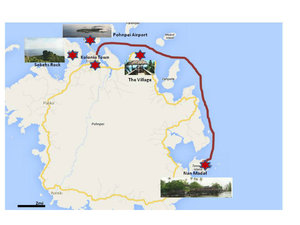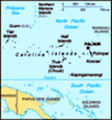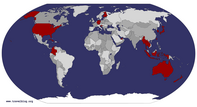Advertisement
Published: March 29th 2013

 Places Mentioned in the Blog Entry
Places Mentioned in the Blog Entry
Pardon my amateurish effort. The red line represents the approximate sea route we took to Nan Madol. I also identify the locations of the other places I visited.This is the first of a select number of past travels I plan to write about. Details may be a little fuzzy because I made this trip almost ten years ago.
Background
In July 2003, a client of mine - a highly-respected not-for-profit organization serving communities in the
Compact of Free Association- asked if I would travel to Pohnpei, capital of the Federated States of Micronesia (FSM), to make a presentation to their board. Micronesia? All expenses paid trip to a remote Pacific Island most people have never heard of? Hell yes! To top that, I get to tick off one more item on my bucket list: flying on Continental Micronesia's (now part of United) legendary Island Hopper service. This flight is legendary among airline geeks. It operates between Honolulu and Guam with five (yes, you read correctly: 5!) stops en route: Majuro and Kwajalein in the Marshall Islands and Kosrae, Pohnpei and Chuuk in the Federated States of Micronesia. Johnston Atoll used to be another stop until the US decommissioned their facility there. Total travel time on the B737-800 that plies this 4,300 mile route is approximately 14 hours. I was bummed that I would not be able to fly all

 My Client's Awesome Staff
My Client's Awesome Staff
They took me under their wing and made sure I was taken care of.the way to Guam on this flight, but I can still claim bragging rights regardless!
The ticket my client purchased had me in Pohnpei for three full days plus two partial days. I was expected to make a presentation lasting an hour (not including prep and questions), and attend opening ceremonies for a conference and the odd function here and there. Beyond that, it was all free time!
I have already written about the flight itself in
another blog, and so I shan't go into any detail here other than to say that it was a long 9.5 hour journey to get from Honolulu to Pohnpei, but I was awake and excited every minute of it! The Guam-based flight crew are among the friendliest I have encountered.
Because this trip happened some time ago, I will describe my time there by theme instead of chronological sequence.
Sightseeing
The standout sightseeing highlight of this trip was, without question, Nan Madol, a fort-like series of stone structures just off the coast of Pohnpei and about two hours by boat from the main town of Kolonia. It was built around 800 years ago in a remarkable feat of engineering,
as the basalt used in its construction is not found anywhere nearby. The people who lived there apparently did not leave artifacts, so there are a lot of unanswered questions about the origins and purpose of the place.
I went to Nan Madol with some of my client's staff on a half-day trip. The small boat took about two hours through waters that got somewhat rough once we went past the reef barrier. Approaching Nan Madol was one of those surreal "whoa" moments; I needed a few moments to take it all in. But then something black and slimy distracted me... sea cucumbers... thousands of them in the knee high water where our boat anchored. I grabbed a couple and started a squirting war :-)
We spent a couple of hours exploring the ruins. I'll let the pictures speak for themselves.
Apart from Nan Madol, I spent a sweltering afternoon hiking up a ridge to an overlook with a view of Sokehs Rock, Kolonia Town and the airport. Along the way, I came across several rusting old tanks from World War II.
Micronesia is best known for diving and snorkeling. Unfortunately, I did not have enough
time to go out snorkeling.
Don't go to Pohnpei expecting to relax on a beach chair while a cabana boy serves you a mai tai. There aren't a lot of sandy beaches; most of the coastline is mangrove forest.
The People
Pohnpeians are very friendly and hospitable and there was no harassment of visitors. It looks as if the majority of them engage in subsistence farming or fishing or are employed by the government. Most houses there appeared to have pigs and chickens. The people were not materially rich, but they did not seem to want much more. It was certainly a welcome change from more touristy places where you can get harassed at every turn.
A number of locals interacted with us, including a hotel employee who brought us out for sakau (a local brew similar to kava), a guy who gave me a ride in his truck, and a former Peace Corp volunteer who married a Pohnpeian and settled here. One friend we made even came to the airport to give us a cooked crab when we left.
I also had dinner with an American friend of a friend who lives in Pohnpei

 Our New Friends
Our New Friends
The two people on the right work at the Cliff Rainbow Hotel. The guy in the photo took us out for sakau.who gave me great insight into the people and way of life and their attitudes towards sexuality. 'Nuff said, unless you are dying to know more.
Back home in Hawaii, though, Micronesians face a very different situation. The US government's Compact of Free Association allows citizens of the Federated States of Micronesia, the Marshall Islands and Palau (collectively known as "Micronesia") the right to live and work in the US without requiring a visa. The Micronesians who have made their way here have higher rates of poverty, homelessness and substance abuse compared to other ethnic groups. Why is this so? I have several hypotheses based on my personal observations of Micronesians in both their homelands and in Hawaii, interactions with various experts as well as from my experience caring for a teenage foster son from the Marshall Islands.
One of my hypotheses is that Micronesians who remain in their homelands are engaged in their environment and way of life, and that those who make their way to Hawaii face few opportunities to interact with their environment in the same way, which in turn means that they become less grounded with their culture and traditions. A second hypothesis I

 Traditional Dance
Traditional Dance
This was a traditional Pohnpeian dance performed in the brand new gymnasium. It was pitch black outside after sundown as there were no street lights!have is that because Micronesians can live in the US without restriction while most other legal immigrants face higher barriers to immigration, many Micronesians who do immigrate to the US tend to be less well equipped than other immigrants to internalize the (mostly economic-driven) value systems in the US. This in turn puts them at the bottom of the economic totem pole when they have to compete for a slice of the pie with Americans and immigrants from other countries who have had a longer learning curve with the US system. A third hypothesis I have is that US foreign aid to Micronesia has created a culture of dependency which leads people to believe that the US will take care of them if they live there.
Anyway, these are just my observations. I welcome any discourse on this.
The Food
Pohnpei is best known for mangrove crab. Look at the picture and see for yourself how massive this typical-sized crab was in relation to the binder next to it. One cooked crab can be bought for $10 from most hotel restaurants. I ate so much crab that I dodged my doctor's reminder to have my cholesterol checked!

 Mangrove Crab
Mangrove Crab
Look at the size of that claw relative to the binder on the left.Food farmed or caught locally tends to be affordable - at most hotels, a $5.50 lunch set will buy you a whole fried fish or fried chicken, rice, a salad (usually shredded cabbage with thousand island dressing), a cup of canned minestrone soup, and a side of sashimi. The sashimi, OMG, was heavenly. The locals tell us that the best tuna gets exported to Japan and that what we ate was second rate. If that was second rate, I cannot imagine what the top grade stuff is like.
PCR Restaurant is highly recommended. PCR stands for Pacific Car Repair; the local car repair shop set up a restaurant! The restaurant at The Village is also recommended.
Food not grown or caught locally is expensive. Beef dishes are expensive. A gander through a local grocery showed that the few veggies on the shelves tended to be hard vegetables such as cabbages and carrots. Milk was expensive too. There was a frightening amount of canned food - spam, vienna sausages, etc. - on the shelves.
The Weather
Unbearably hot and humid. I would even break a sweat crossing the hotel courtyard. I took seven showers one day. I gave
up wearing underwear within a few hours of arriving in Pohnpei. I know - TMI.
The Infrastructure
Lots of bizarre contrasts here. FSM Telecom had the most impressive building in Kolonia, but the phones did not work too well - I wasted $20 on an international calling card that I couldn't get to work on their phones. Credit card readers did not work even once while I was there because the connections were unreliable. Roads in Kolonia town were potholed and waterlogged, but outside town there is a nice, paved road maintained by the US military.
It took me about two full days to figure out that people were supposed to drive on the right here. Many of the cars in Pohnpei were imported used from Japan, so the vehicles there were a mix of right- and left-hand drive. It also didn't help that many drivers drove on the middle of the road to avoid potholes and dogs.
There were quite a few wrecked ship hulls half-submerged in the harbor. Not sure why they have not been salvaged.
Don't expect a fancy airport. The baggage claim is a single metal counter. There was betel nut

 Kolonia Town
Kolonia Town
Viewed from Sokehs Rock.spit in the urinals. Ew.
I did not see much garbage piled up, but I did wonder how they disposed of it on such a remote island. Water and sanitation did not appear to be much of an issue from what I observed, but I could be wrong on that.
There are no vets on the island. According to my expat friend, a vet flies in from Guam once a year and opens a temporary clinic for a few days.
Finally, the most stark contrast in infrastructure happened when I attended the opening ceremony of my client's conference. The ceremony was held in a beautiful, spanking new gymnasium built by the Chinese (probably in exchange for fishing rights). The ceremony began before nightfall, and when were walked out at the end of the ceremony, the area around the gymnasium was pitch black - no street lighting at all!
Souvenirs and Things To Buy
Handicrafts using shells and mangrove wood are reasonably priced. There is a street not far out of Kolonia with many shops selling these handicraft. Pohnpei pepper is regarded to be among the best in the world but you may have trouble getting
it into the US.
Travel Tips
Stopovers on the Island Hopper: At Kosrae, I highly recommend getting off the plane to buy tangerines. Make sure you consume them before you arrive at Honolulu. I also bought a chili and lime condiment there that was allowed into the US at Honolulu Airport after an inspector examined it.
Accommodation: You won't have many choices for accommodation. My client put me up at the Cliff Rainbow Hotel for under $100 per night. The rooms were a little ragged but it was a clean and friendly place near Kolonia. Most importantly, the aircon was cold! The only romantic getaway-type place is The Village. The rooms there are open air with no aircon.
Eating: As mentioned earlier, PCR Restaurant is highly recommended, as is The Village. Most of the other hotels, including the Cliff Rainbow, have reasonably good restaurants.
Currency: The US dollar is the currency used in Micronesia.
Final Thoughts
I never dreamed I would ever see this part of the world. Do go there if you can. It's not the most traveler-friendly place in terms of ease of movement and tourist infrastructure, but you'll be welcomed.
Advertisement
Tot: 0.204s; Tpl: 0.037s; cc: 8; qc: 33; dbt: 0.0361s; 1; m:domysql w:travelblog (10.17.0.13); sld: 1;
; mem: 1.2mb









 Former Homes
Former Homes  Been
Been  Home
Home 










































